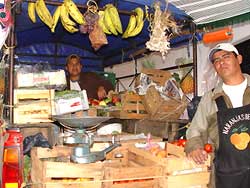
Photo by Loren Starr, from Michigan
Mexican anthropologist Alejandro Morroquín, in his book La Ciudad Mercado (Tlaxiaco), suggests that the following five distinct elements constitute a typical Mexican mercado:
- The physical component, which includes the ground occupied by the market, the merchandise, wood dividers between stalls, pushcarts, busses that carry customers, and even the mecapales used by Indians carrying loads on their backs.
- Mercado activities, which Morroquín observes may take place in "apparent disorder," but which ultimately result in a "weakly systematized, coordinated collective realization." Typical activities are the morning unloading of trucks coming in from the countryside or the Central de Abastos, the carting of the trucks' produce to appropriate stalls inside the mercado, and the vendors' perpetual sorting and rearranging of produce.
- Marketplace norms and customs, such as the manner in which fruit is arranged in piles on tables, the degree of cleanliness maintained inside the mercado, and the markup price chosen by the vendors.
- Mercado ideology, consisting, for example, of all the state, federal, and municipal laws governing mercado transactions, the religious percepts influencing how mercado participants interact with one another, and the local people's traditional concepts of how business should be conducted.
- People in the mercado; Morroquín divides them into five groups:
- Professional merchants, including those selling from one location, those who circulate, and those who do both
- serious customers coming expressly to buy
- Passers-by, who come just for the fun of it, but who may end up buying something
- Mercado authorities, such as the police and mercado administrators
- "Complementary workers," such as loaders and carpenters
Morroquín further mentions the presence of beggars, whom he sorts into two categories: those who beg for themselves, and those who solicit on behalf of particular causes. Furthermore, as seen in our "One Day in the Life of a Mercado" section, those wandering through selling patent medicines, magical charms, and the like, and the prostitutes who sometime work on the perimeters of large markets, should also be remembered.